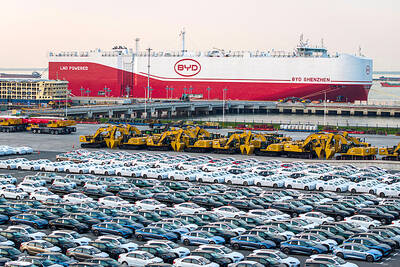For 61-year-old construction worker Chae Chang-geun, an ethnic Korean from China, Seoul is a place to make money, but not a place to call home.
Chae is one of the 450,000 people from the Korean diaspora born in China who make up 40 percent of the immigrant workforce in South Korea.
With one of the fastest-aging populations among developed nations, South Korea will become increasingly dependent on foreign labor. Yet the ethnically homogenous country of 50 million can barely bring itself to welcome its own kin, let alone “foreign” labor.

Photo: Reuters
“Technically, this country is our motherland,” said Chae, who like other ethnic Koreans from China thought he would be welcomed in South Korea because of a shared cultural history.
Instead, many of these immigrants say they are treated coldly, picked on by locals for their accents and treated with distrust.
“We feel like we are a minority in both China and South Korea,” Chae said.
South Korea has had a remarkable rise from the devastation of the Korean War six decades ago to now stand as the world’s 15th-biggest economy, home to globally recognized brands such as mobile phone and chipmaker Samsung Electronics Co and automaker Hyundai Group.
However, its population is the fastest-aging among the industrialized countries in the Organisation for Economic Co-operation and Development. Immigration will almost certainly be needed to keep the economy growing as the ratio of senior citizens to working-age people — now 1:5.6 — is projected to shift dramatically to 1:1.2 in the next 50 years.
“The Republic of Korea should be using immigration as part of a multipronged strategy to deal with its changing demographics and aging issues,” said Amlan Roy, managing director and researcher for global demographics and pensions research at Credit Suisse Group AG in London.
The risk is that without immigration, the population will continue shrinking and fail to provide enough taxpayers to fund a social welfare burden that is set to grow as the country ages. Fewer workers could push up hiring costs, prompting firms to move production offshore to remain competitive, effectively hollowing out the economy.
South Korea has to become more accepting of immigration and the experience of Korean-Chinese — the biggest immigrant group in the country — suggests that may take time, said Lim Dae-geun, professor of Chinese studies at Hankook University of Foreign Studies in Seoul.
“They are the same Koreans, but their nationality is Chinese and they are the bottom class of South Korea’s economy,” Lim said. “They are treated as needy people that have jobs that are physically tough and low paying.”
A broad assumption is that Korean-Chinese are taking jobs away from locals, although more than 84 percent of companies surveyed last year by Seoul’s Korea Chamber of Commerce and Industry said that was not the case.
Half the firms said they wanted to hire more foreign labor, but were restricted by government-set quotas. Migrants make up just 9 percent of total manufacturing workers, much less than for example Singapore, where they make up 39 percent.
The South Korean Ministry of Justice, which handles visas for foreigners, said it has “concerns” about cheap Chinese labor taking local jobs. Visa rules for Korean-Chinese are more restrictive than for other overseas Koreans.
The South Korean Ministry of Labor said it has similar concerns.
“Too much migrant workforce could hamper work conditions and deprive opportunities for underprivileged South Koreans,” said Jang Hyun-suk, senior deputy director at the labor ministry’s foreign workforce division.
The term given to Korean-Chinese, joseonjok, describes the descendants of Koreans who fled to China in the late 1800s and early 1900s in the face of famine and Japanese occupation.
Advocacy groups say the name is associated with negative connotations in the media, such as by highlighting crimes committed by these immigrants, although their crime rate is less than the national average.
Baek Chung-kang, the son of Korean-Chinese parents, felt the full force of discrimination after he won a TV contest that launched him as a pop singer. However, after being diagnosed with cancer, he was attacked online.
“We have no sympathy with joseonjok,” read one comment about his illness, while another said: “You should thank South Korea because you would be dead by now if you were in China.”
An arson attack that razed a shelter in Seoul used by immigrants epitomized for many Korean-Chinese workers the isolation they feel.
“Although now we face a difficult path, we will work together and win,” shelter resident Lee Kwon-hwa said.
As he looked at the ruins, Chae seemed more downbeat.
“Life is not beautiful here,” the construction worker said.

Micron Memory Taiwan Co (台灣美光), a subsidiary of US memorychip maker Micron Technology Inc, has been granted a NT$4.7 billion (US$149.5 million) subsidy under the Ministry of Economic Affairs A+ Corporate Innovation and R&D Enhancement program, the ministry said yesterday. The US memorychip maker’s program aims to back the development of high-performance and high-bandwidth memory chips with a total budget of NT$11.75 billion, the ministry said. Aside from the government funding, Micron is to inject the remaining investment of NT$7.06 billion as the company applied to participate the government’s Global Innovation Partnership Program to deepen technology cooperation, a ministry official told the

Taiwan Semiconductor Manufacturing Co (TSMC, 台積電), the world’s leading advanced chipmaker, officially began volume production of its 2-nanometer chips in the fourth quarter of this year, according to a recent update on the company’s Web site. The low-key announcement confirms that TSMC, the go-to chipmaker for artificial intelligence (AI) hardware providers Nvidia Corp and iPhone maker Apple Inc, met its original roadmap for the next-generation technology. Production is currently centered at Fab 22 in Kaohsiung, utilizing the company’s first-generation nanosheet transistor technology. The new architecture achieves “full-node strides in performance and power consumption,” TSMC said. The company described the 2nm process as

Shares in Taiwan closed at a new high yesterday, the first trading day of the new year, as contract chipmaker Taiwan Semiconductor Manufacturing Co (TSMC, 台積電) continued to break records amid an artificial intelligence (AI) boom, dealers said. The TAIEX closed up 386.21 points, or 1.33 percent, at 29,349.81, with turnover totaling NT$648.844 billion (US$20.65 billion). “Judging from a stronger Taiwan dollar against the US dollar, I think foreign institutional investors returned from the holidays and brought funds into the local market,” Concord Securities Co (康和證券) analyst Kerry Huang (黃志祺) said. “Foreign investors just rebuilt their positions with TSMC as their top target,

POTENTIAL demand: Tesla’s chance of reclaiming its leadership in EVs seems uncertain, but breakthrough in full self-driving could help boost sales, an analyst said Chinese auto giant BYD Co (比亞迪) is poised to surpass Tesla Inc as the world’s biggest electric vehicle (EV) company in annual sales. The two groups are expected to soon publish their final figures for this year, and based on sales data so far this year, there is almost no chance the US company led by CEO Elon Musk would retain its leadership position. As of the end of last month, BYD, which also produces hybrid vehicles, had sold 2.07 million EVs. Tesla, for its part, had sold 1.22 million by the end of September. Tesla’s September figures included a one-time boost in